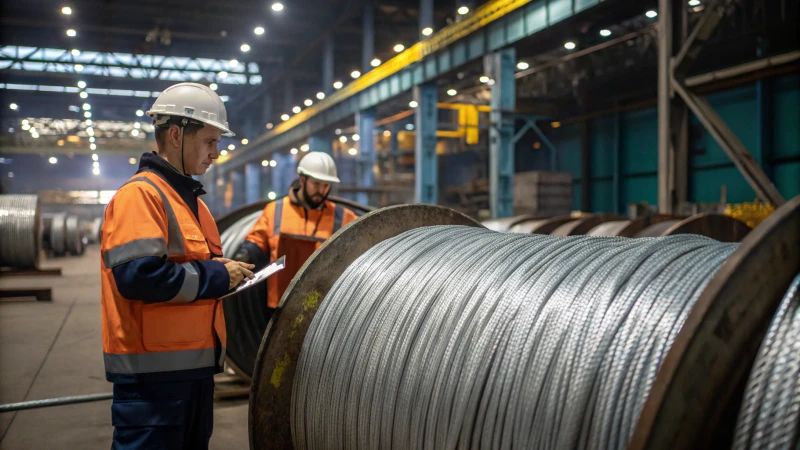
Navigating the maze of steel wire rope certifications can feel daunting, but it's crucial for ensuring safety and performance.
Certifications like ISO 2408, EN 12385, and DIN 3060 are essential for ensuring steel wire rope quality. They establish the standards for tensile strength, construction, and testing. These certifications, along with third-party endorsements from TÜV or SGS, ensure that the ropes comply with safety and environmental regulations, offering reliability in demanding conditions.
I remember the first time I was tasked with selecting steel wire ropes for a major project. The sheer number of certifications seemed overwhelming. However, as I delved deeper, I realized how these standards—ISO 2408, EN 12385, and DIN 3060—translate into tangible safety and reliability. Understanding them became not just about ticking boxes but about ensuring the success and safety of our operations.
When you consider these certifications, think of them as the backbone of your procurement strategy. They guide you in choosing products that not only meet but often exceed the rigorous demands of industrial applications. This knowledge empowers you to make informed decisions, ensuring that each rope you choose stands up to the test when it matters most.
ISO 2408 sets tensile strength requirements for steel wire ropes.True
ISO 2408 specifies technical conditions for steel wire ropes, including tensile strength.
DIN 3060 is unrelated to steel wire rope construction.False
DIN 3060 provides standards for the construction of steel wire ropes.
How Do ISO and EN Standards Affect Steel Wire Rope Manufacturing?
Standards might sound dry, but they're the backbone of safety and quality in steel wire rope manufacturing. Dive in to see how they make a real difference.
ISO and EN standards shape steel wire rope manufacturing by enforcing rigorous quality and safety benchmarks. These guidelines ensure ropes meet international expectations, boosting durability and minimizing failure risks.

Understanding Key Standards
Imagine you're responsible for a massive construction project. You're sourcing steel wire ropes that need to withstand incredible loads—like holding up entire sections of a building while they're being hoisted into place. That's where ISO 24081 and EN 123852 come into play. These standards dictate everything from the minimum breaking force to the construction types of these ropes. It's like having a trusted checklist to ensure safety isn't just a priority, but a guarantee. ISO 2408, for instance, mandates a minimum breaking force that acts as a safeguard against catastrophic failures, while EN 12385 lays out meticulous testing methods to ensure every rope is ready for the real world.
Quality Assurance through Standards
Think about the last time you drove over a bridge or took an elevator. Those steel cables holding everything together? They've been rigorously tested thanks to ISO and EN standards. Each rope undergoes assessments for tensile strength, corrosion resistance, and fatigue. Imagine ropes in a laboratory being stretched to their limits, enduring salt spray to test for rust, and being bent repeatedly to simulate years of use—all so they can perform flawlessly in your most critical applications. And when they pass, third-party certifications like those from TÜV3 provide an extra layer of trust.
The Role of Standards in Safety
Safety isn't just a buzzword—it's the lifeline in industries like mining and construction. I've often wondered what it would be like working several stories up or deep underground, relying on these ropes for safety. Thanks to ISO and EN standards, these ropes are designed to withstand harsh environments and extreme loads, drastically reducing risks of accidents or equipment failure. It's reassuring to know that when lives are literally hanging by a thread, those threads are some of the strongest available.
Table: Comparative Overview of ISO and EN Standards
| Standard | Key Focus | Impact on Manufacturing |
|---|---|---|
| ISO 2408 | Minimum breaking force | Ensures ropes can handle extreme loads |
| EN 12385 | Construction and testing methods | Details production processes |
Global Implications of Compliance
In today's interconnected world, complying with ISO and EN standards isn't just smart—it's essential. For manufacturers like us looking to expand globally, these standards open doors. They communicate our commitment to quality and reliability, fostering trust with international clients who demand the best. I remember my first big overseas order; knowing our products met these standards gave me confidence and helped forge strong partnerships built on mutual trust.
While this is just scratching the surface, delving deeper into real-world examples can shed light on how these standards are practically applied across industries. It's a fascinating intersection of regulation and innovation.
ISO 2408 mandates a minimum breaking force.True
ISO 2408 specifies the minimum breaking force to ensure safety.
EN 12385 focuses on rope color coding.False
EN 12385 details construction and testing, not color coding.
How do third-party certifications enhance quality assurance?
Imagine having an expert vouch for your product's quality. That's the power of third-party certifications.
Third-party certifications act as an impartial endorsement of a product's compliance with established quality standards, fostering trust, ensuring regulatory compliance, and boosting overall quality assurance within businesses.

Understanding Third-Party Certifications
I remember the first time I had to select steel wire ropes for a major project. The array of options was daunting, but what truly stood out were those with third-party certifications. These certifications, issued by independent organizations, evaluate a product's compliance with industry standards. In the steel wire rope industry, for instance, bodies like TÜV or SGS ensure adherence to standards like ISO 2408, which is critical in high-stakes fields like construction4 and mining.
Enhancing Product Reliability
One story sticks with me about John, a construction procurement manager who once faced a tight deadline. He needed reliable wire ropes that wouldn't compromise safety or timelines. Certified products offered him the peace of mind that the ropes could handle heavy-duty use without breaking under pressure.
Compliance with Regulations
Regulations can be a maze, can't they? I've seen Emma, a mining equipment procurement officer, navigate these complexities with certified products that assure compliance with stringent safety and environmental standards. These certifications not only shield businesses from legal repercussions but also bolster their market reputation.
Facilitating Global Trade
In our global market, entering new territories feels like unlocking new levels in a game. Products with international certifications often have the upper hand. Klaus, a heavy machinery procurement officer in Germany, shared how he prioritizes suppliers whose certifications align both locally and globally, easing trade barriers and ensuring compatibility.
| Certification Body | Role in Quality Assurance |
|---|---|
| TÜV | Provides testing and certification services |
| SGS | Verifies compliance with various standards |
These bodies play a pivotal role in maintaining product specifications and consistency—keys to building trust in long-term supplier relationships.
Building Consumer Trust
Trust isn't just a buzzword; it's the bedrock of consumer relationships. Sarah, a mining operations manager I know, values certifications because they translate into reduced operational risks and increased product credibility. In industries where a single product failure can spell disaster, this assurance is invaluable.
Reflecting on these experiences, it's clear that third-party certifications are more than just regulatory checkboxes. They're crucial allies in the quest for quality assurance, helping confirm a product's reliability while enhancing its appeal across borders.
Third-party certifications confirm product compliance.True
Certifications from bodies like TÜV verify adherence to standards.
Certifications are optional for global market entry.False
Certifications reduce trade barriers, making them essential for entry.
Why Is Compliance with International Standards Crucial for Safety?
Have you ever wondered how a simple set of rules could change the game in industrial safety?
Compliance with international standards is essential for ensuring safety, as it minimizes risks, enhances reliability, and fulfills legal obligations. These standards create a framework for consistent quality and safety measures, reducing the chances of accidents.

Understanding International Standards
When I first started dealing with international standards like ISO 90015 and ISO 450016, I felt like I was navigating a maze of technical jargon. But as I dug deeper, I realized these standards are like a universal language for quality and safety. They set the benchmarks that ensure products and services we rely on every day are safe and reliable.
The Role of Compliance
Compliance isn't just about ticking boxes; it's about keeping people safe and operations smooth. Take the steel wire rope industry, for example. Imagine relying on a rope to hold up tons of weight daily. Standards dictate the tensile strength7 and construction to make sure they can handle such stress without snapping. It's not just about avoiding accidents; it's about peace of mind.
Benefits Across Industries
| Industry | Key Standards | Benefits |
|---|---|---|
| Construction | ISO 2408 | Ensures safety under heavy loads |
| Mining | EN 12385 | Enhances durability in extreme conditions |
| Marine | DIN 3060 | Provides corrosion resistance |
In construction, following standards is akin to a lifeline—literally. They ensure that materials, like those heavy-duty steel wire ropes, perform reliably under pressure. In mining, it's about withstanding tough environments. It's fascinating how adhering to these rules can transform ordinary operations into secure ones.
Third-Party Certifications
I remember the first time I dealt with third-party certifications from bodies like TÜV or SGS. It was reassuring to have an extra layer of validation that the products met all necessary safety and environmental regulations. Following these standards is not just about compliance; it's about building trust with clients and ensuring that our workforce is safe. Understanding what could go wrong if we don't comply made me appreciate these standards even more. They’re indispensable in today’s global market.
ISO 9001 focuses on occupational health and safety.False
ISO 9001 is for quality management, not occupational health and safety.
Compliance reduces legal liabilities in industries.True
Adhering to standards helps prevent legal issues by ensuring safety.
How do I choose a supplier that meets industry standards?
I remember the first time I had to choose a supplier; it felt like trying to solve a complex puzzle without all the pieces. Here's how I learned to make it a bit easier.
Choosing a supplier that aligns with industry standards involves checking their certifications, evaluating production capabilities, reviewing their track record, and ensuring they have solid quality assurance processes. Building strong relationships and confirming their customer support are crucial steps to success.

Evaluating Compliance and Certifications
I can't stress enough how important it is to verify that a supplier complies with industry standards and certifications8. When I was sourcing steel wire ropes, I focused on certifications like ISO 2408 and EN 12385. Suppliers who can provide this documentation or third-party certification have always given me peace of mind, knowing they're not just about talk but about real safety and quality.
Assessing Production Capabilities
Understanding a supplier's production capacity is crucial. I remember once making a chart to compare potential suppliers:
| Criteria | Supplier A | Supplier B |
|---|---|---|
| Capacity (units/month) | 10,000 | 15,000 |
| Lead Time (weeks) | 4 | 6 |
| Quality Control | ISO 9001 | ISO 14001 |
This table helped me visualize which supplier could meet my needs, especially when deadlines were looming. Such comparisons allow you to see which supplier aligns best with your project requirements9.
Reviewing Past Performance
I've learned to dig into a supplier's history through case studies or client feedback. There was one time I found data on product failures that saved me from potential future headaches. Analyze the supplier's track record through case studies or client feedback by asking for data showing product failure rates or incidents related to non-compliance with industry standards10. This step is invaluable for gauging reliability.
Evaluating Quality Assurance Processes
A strong quality assurance process is like a safety net. A robust quality assurance process is a hallmark of a reliable supplier. Ensure they have systems for regular checks and balances to maintain product integrity. Engage in detailed discussions and ask for audits or documentation helps ensure they truly maintain product integrity.
Building Long-Term Relationships
Long-term partnerships can be incredibly beneficial. Consider the benefits of forming long-term partnerships with suppliers who consistently deliver quality products. I've seen firsthand how these relationships result in better pricing and priority treatment. Evaluate how each supplier values customer relations11 and their approach to service.
Verifying Customer Support
Reliable customer support can be a game-changer. Excellent customer support can make a significant difference when issues arise. I've tested this by reaching out with hypothetical queries to see how they respond. Good suppliers offer technical support, maintenance advice, and prompt solutions, ensuring smooth operations when things go awry.
By focusing on these key areas, I've been able to choose suppliers who not only meet but often exceed industry standards, delivering exceptional products and services.
ISO 2408 is a standard for steel wire rope manufacturing.True
ISO 2408 specifies requirements for steel wire ropes, ensuring quality and safety.
Supplier B has a shorter lead time than Supplier A.False
Supplier A has a lead time of 4 weeks, whereas Supplier B's is 6 weeks.
Conclusion
Steel wire rope quality is ensured through certifications like ISO 2408 and EN 12385, which set safety standards for tensile strength and construction, supported by third-party endorsements.
-
Explore detailed specifications of ISO 2408 to understand its impact on steel wire rope safety and performance. ↩
-
Discover the construction guidelines specified by EN 12385 to see how they influence manufacturing quality. ↩
-
Learn how TÜV certification reinforces compliance with international safety standards. ↩
-
This link will offer insights into how certifications impact the construction industry, highlighting their role in ensuring safety and reliability. ↩
-
Explains the importance of ISO 9001 in quality management systems. ↩
-
Describes how ISO 45001 improves workplace health and safety. ↩
-
Outlines the critical tensile strength specifications ensuring rope safety. ↩
-
Understanding certifications ensures the supplier meets quality and safety benchmarks critical for procurement decisions. ↩
-
Knowing production capabilities helps determine if the supplier can meet demand and maintain quality. ↩
-
Understanding failure rates helps assess product reliability and potential risks involved with the supplier. ↩
-
Strong customer relations can lead to better service, pricing, and support, crucial for long-term success. ↩

